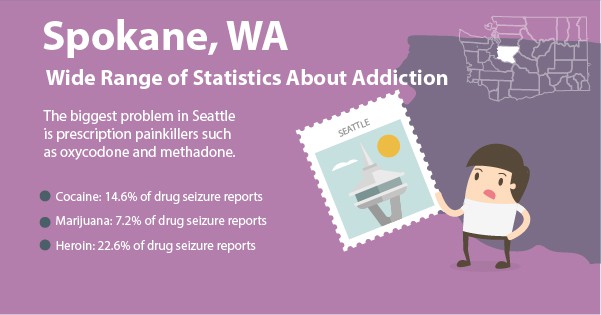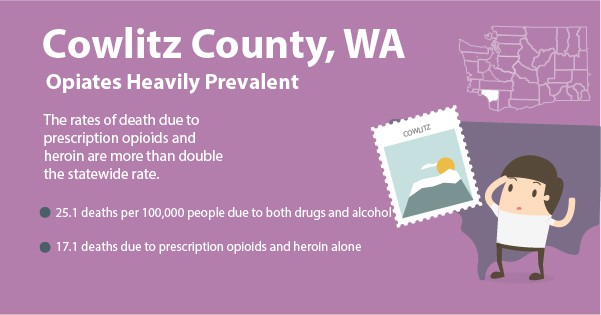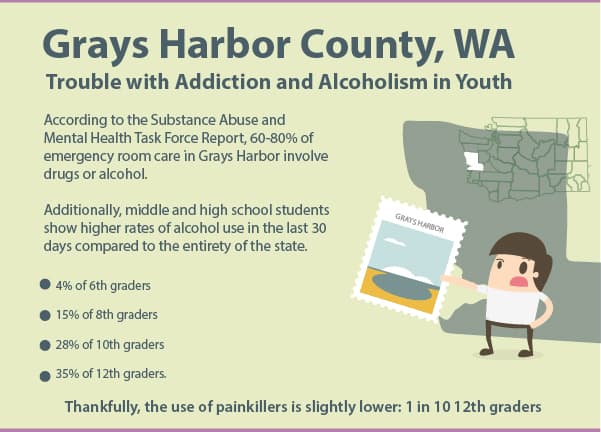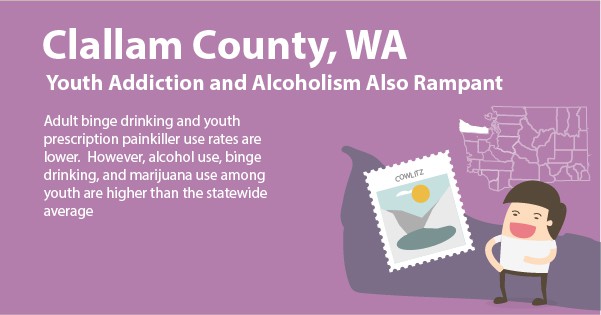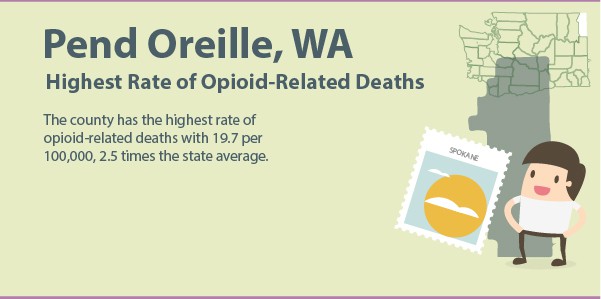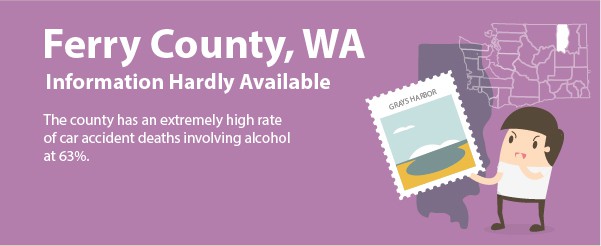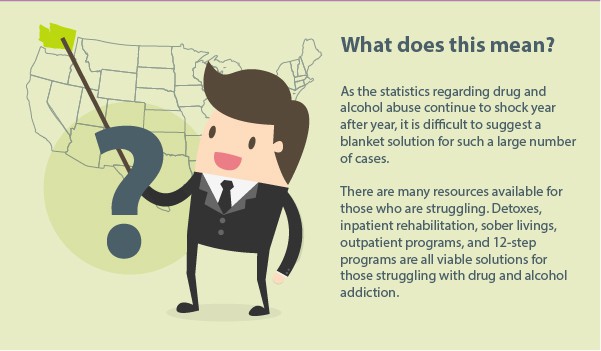Drug abuse rates have been on the rise in Washington state. According to the latest addiction statistics in Washington state:
- 15 per 100,000 people have died due to drug-related causes
- 8.6 of those deaths are attributed to opiates alone
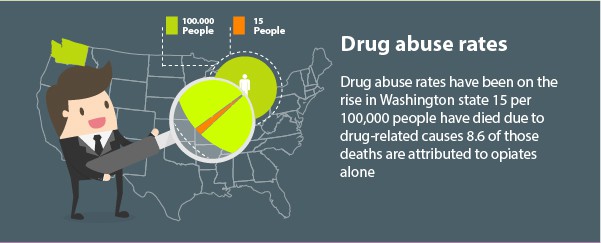 With 1,033 total deaths attributed to drugs in 2011 and the rates steady since 2005, this terrifying trend shows no signs of stopping soon. Counties with rates of death higher than the state average include:
With 1,033 total deaths attributed to drugs in 2011 and the rates steady since 2005, this terrifying trend shows no signs of stopping soon. Counties with rates of death higher than the state average include:
- Cowlitz (25 deaths per 100,000 people)
- Grays Harbor (23 deaths per 100,000 people)
- Clallam (21 deaths per 100,000 people)
- Snohomish (18 deaths per 100,000 people)
- Spokane (17 deaths per 100,000 people)
Healthy People 2020 set the goal of reducing the average to 11.3 by 2020, but if the pattern continues Washington state is unlikely to meet this aim. The statistics regarding alcohol use in Washington state are shocking as well. In 2010, 2,457 alcohol-related deaths were reported. 16% of adults reported binge drinking (5 or more drinks for men, 4 or more drinks for women) at least once in the past month. San Juan, Grays Harbor, and King counties reside above the state average, with 22%, 21% and 17% of adults reporting binge drinking in the past month, respectively. Looking at nationwide statistics, Washington state is just above the national average of 14.6 deaths attributed to drug use. In 2013, a total of 46,471 people in the United States died of drug-related causes. When it comes to alcohol use, Washington state is on par with the national average, with 17% of adults binge drinking about four times a month. Washington state is following in America’s footsteps with its alarming drug and alcohol abuse trend so we’ve broken down some of the statistics per city or county where they are available. 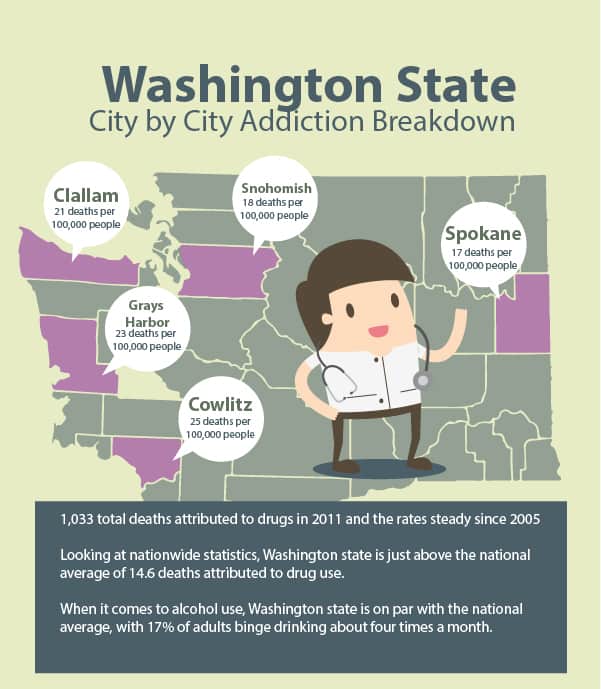
Seattle, WA: Wide Range of Statistics About Addiction
The National Institute on Drug Abuse conducted a study in Seattle in 2013 to determine the prevalence the various drugs in drug seizure and analysis reports.
- Cocaine: 14.6% of drug seizure reports
- Marijuana: 7.2% of drug seizure reports
- Heroin: 22.6% of drug seizure reports
The presence of cocaine and marijuana in these seizure reports has lowered steadily compared to previous years. However, as their presence decreases, heroin is quickly overtaking them. In 2012, heroin accounted for 17.9% of seizure reports. While still low in total deaths caused, the prevalence of methamphetamines is also on the rise. In 2011, 7 deaths due to methamphetamines were reported, but this number tripled to 21 in 2013. The biggest problem in Seattle is prescription painkillers such as oxycodone and methadone. Drug-related deaths attributed to these seemingly safe drugs are increasing exponentially, with rates at 3.5% of reports in 2012 to 5.7% of reports in 2013.
Spokane, WA: Opioid Use and Overdose Rates
The Spokane Regional Health District conducted a report to determine the amount of adults and high school students using a prescription opioid medication to get high in the past 30 days. Results showed 1 in 100 adults and 1 in 10 high school students used a prescription opioid to get high, rather significant numbers of people, especially at the high school level. 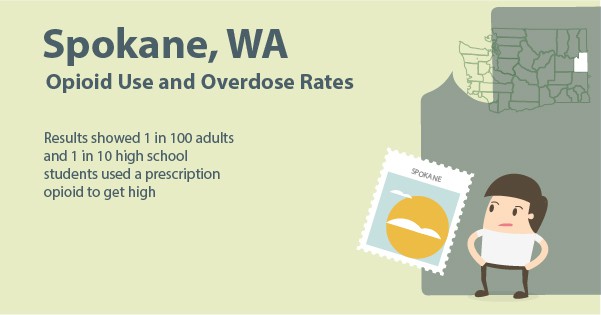 Additionally, prescription opioid overdose rates increased exponentially from 2000 to 2009. Research showed a 102% increase in emergency room visits and a 213% increase in hospitalizations.
Additionally, prescription opioid overdose rates increased exponentially from 2000 to 2009. Research showed a 102% increase in emergency room visits and a 213% increase in hospitalizations.
Cowlitz County, WA: Opiates Heavily Prevalent
Presently, the death rates in Cowlitz county rise high above the statewide average.
- 25.1 deaths per 100,000 people due to both drugs and alcohol
- 17.1 deaths due to prescription opioids and heroin alone
The rates of death due to prescription opioids and heroin are more than double the statewide rate. Though efforts to reduce drug and alcohol abuse have sprung up county-wide, statistics show they have been somewhat ineffective. It is difficult to continually develop unique solutions when efforts continue to fall flat.
Grays Harbor County, WA: Troubles with Addiction and Alcoholism in Youth
According to the Substance Abuse and Mental Health Task Force Report, 60-80% of emergency room care in Grays Harbor involve drugs or alcohol. The county’s undersheriff estimates that 80% of law enforcement encounters are related to drugs or alcohol. 48% of driving-related deaths involved alcohol. Grays Harbor also reports adults binge drinking at a higher rate of 21% compared to the statewide average of 16%. Additionally, middle and high school students show higher rates of alcohol use in the last 30 days compared to the entirety of the state.
- 4% of 6th graders
- 15% of 8th graders
- 28% of 10th graders
- 35% of 12th graders.
Rates of marijuana and other illicit drug use are also high among Grays Harbor teenagers with 1 in 5 10th graders using marijuana or an illegal drug in the last 30 days. Thankfully, the use of painkillers is slightly lower: 1 in 10 12th graders have used painkillers to get high in the last 30 days.
Clallam County, WA: Youth Addiction and Alcoholism Also Rampant
Adult binge drinking and youth prescription painkiller use rates are lower in Clallam county compared to the statewide use in Washington state. However, alcohol use, binge drinking, and marijuana use among youth are higher than the statewide average. Though the rates are higher, a report from Clallam County Health and Human Services shows rates of use among youth are decreasing as time passes.
Pend Oreille County, WA: Highest Rate of Opioid-Related Deaths
Limited information regarding Pend Oreille county is available, but the county has the highest rate of opioid-related deaths with 19.7 per 100,000, 2.5 times the state average.
Ferry County, WA: Information Hardly Available
Again, there is not much information regarding Ferry county. However, they have an extremely high rate of car accident deaths involving alcohol at 63%.
What does this mean?
Despite the alarming statistics surrounding Seattle, extensive research on counties where the impact of drug and alcohol abuse is more severe tends to be lacking. This is likely due to Seattle being one of the largest cities in the state. However, if rates are higher in other locations then more research needs to be done. Though some county-wide data is available, it is difficult to locate anything at a city-specific level. Without proper data, it will be difficult to understand what exactly is going on in these affected areas. With rates being more severe despite their smaller populations, it is imperative that more research is conducted in order to provide better assistance. As the statistics regarding drug and alcohol abuse continue to shock year after year, a demand for a solution continues to rise, but it is difficult to suggest a blanket solution for such a large number of cases. Instead, talk with your loved ones in whom you think there may be a problem. While a wider solution needs to be made available, it is easier to work with the individuals close to us on a person-by-person basis. There are many resources available for those who are struggling. Detoxes, inpatient rehabilitation, sober livings, outpatient programs, and 12-step programs are all viable solutions for those struggling with drug and alcohol addiction. If the person has an honest desire to get sober there are places for them to go. Make use of the many programs offered and seek a solution to addiction today.
Full Infographic:
Resources
“Washington Drug Control Update” WhiteHouse.gov “Annual Causes of Death in the United States” DrugWarFacts.org “Binge Drinking” Centers for Disease Control and Prevention “Opioid Prescribing: Spokane County Dentists” Spokane Regional Health District “Cowlitz County overdose fatality rate remains among state’s highest” The Daily News “Community Health Profile” Grays Harbor Public Health & Social Services “A Report Card on Clallam County’s Health” Clallam County Health and Human Services “Ferry” County Health Rankings and Roadmaps

